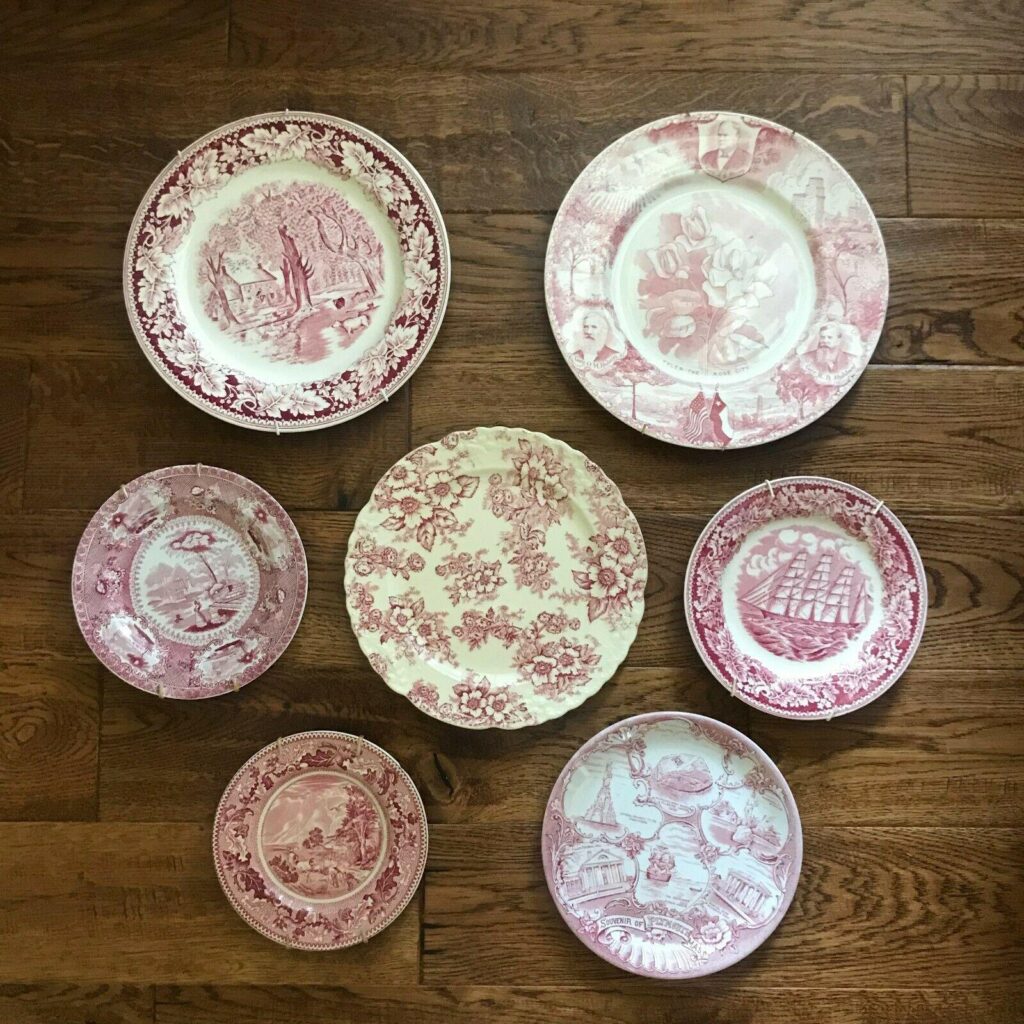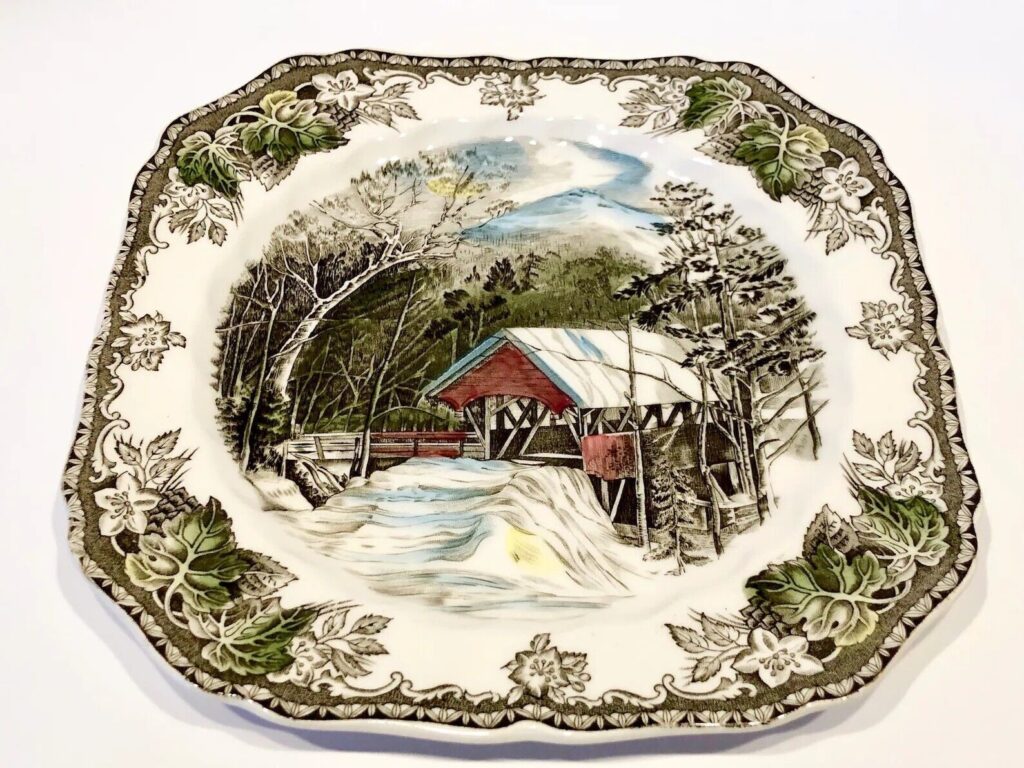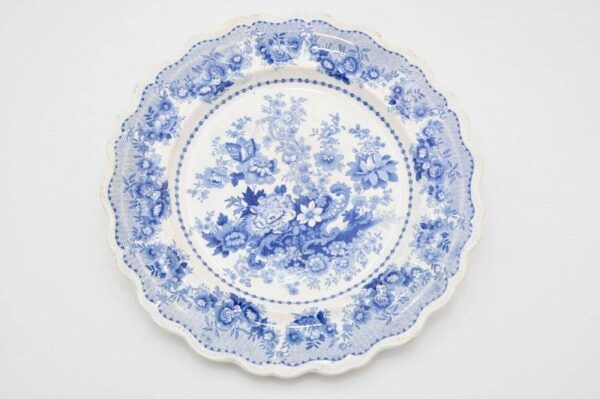#Questions #Collectors #Transferware #WorthPoint

Transferware is as popular today as it was two hundred years ago. It can be found in various patterns, colors, pieces, and price points. Perhaps its array of choices is part of its appeal. Whether you are just starting your transferware collection or want to add a few pieces to an existing collection, the answers to the following questions will help you best navigate your next vintage transferware purchase.
WHAT IS TRANSFERWARE?
Transferware is pottery featuring an applied pattern. Manufacturers transferred an inked design engraved on copper plates onto paper and then pressed it onto undecorated pottery. They then dipped the pottery in water to remove the paper before glazing and firing it in a kiln. Though blue is the most common, makers also produced transferware in brown, red (pink), green, yellow, gray, black, mulberry (purple), and multi-colored patterns.
Developed in England during the late 18th century, the transfer process saved significant time over hand-painting the pottery and cost much less to produce. Manufacturers could mass-produce transferware, which made the items more affordable and thus more popular in the 1820s and 1830s. Initially copied from intricate blue and white Chinese designs found on hand-painted porcelain, early transferware patterns soon evolved into simpler designs appealing to consumers worldwide. Today, transferware continues to be produced outside of England.
WHAT TRANSFERWARE PATTERNS ARE POPULAR?
Most transferware has a white background with a single-color pattern. Since pottery manufacturers produced thousands of transferware patterns, it is difficult to identify every pattern. However, most transferware patterns feature a theme. Within those themes, certain patterns stand out from the rest.
The Asian influence theme includes oriental patterns based on Chinese designs found on hand-painted porcelain. The Blue Willow pattern is likely the most well-known example of Asian-influenced transferware. Blue Willow transferware, created during the late 1700s, appears in many variations made by hundreds of makers today.
Floral theme transferware pieces include all types of flowers featured centrally, around the edge, or both. English Chippendale by Johnson Brothers Pottery is a favorite floral pattern. Johnson Brothers produced the pattern from 1935 to 1965.
The architecture theme includes important places and historic sites. For example, the Liberty Blue pattern by potteries in Staffordshire, England, is highly collectible and features Independence Hall, formerly home to the Liberty Bell, surrounded by a blue and white floral trim. Staffordshire manufacturers produced the pattern from 1975 to 1981.
Landscape theme transferware pieces include both rural and urban landscapes. The Friendly Village by Johnson Brothers stands out from other landscape transferware due to its multi-color pattern. Johnson Brothers produced the pattern from 1953 to 2003.

The animal theme includes woodland creatures, birds, livestock, and fish. Some animals appear in the background of a landscape scene, while others appear in the foreground of the piece. Since Thanksgiving is mostly celebrated around the table, tableware featuring a turkey is a popular example of animal-themed transferware. One of those favorite patterns is His Majesty by Johnson Brothers, produced from 1955 to 1983.
These transferware production dates refer to the original manufacturing of the patterns. Some popular transferware patterns, like Johnson Brothers Pottery’s The Friendly Village and His Majesty, are still produced today but made in China instead of England. The newer transferware’s backstamp reads “Johnson Bros England 1883,” whereas the original backstamp reads “Made in England by Johnson Bros.”
HOW DO YOU DATE TRANSFERWARE?
Most early transferware pieces have a mark or backstamp to identify the maker, pattern, and year of manufacture. The date usually refers to the year the pattern was introduced or patented. Some marks show an image that represents a particular manufacturer. Researching the mark or backstamp can help identify your transferware and provide a general timeframe of when the manufacturer made the piece.
Some early pieces only include “England” or “Made in England” on the back or bottom. Transferware with an “England” backstamp was made between 1890 and 1920. Meanwhile, pieces made after 1920 include the “Made in England” backstamp.
It is not easy to date unmarked transferware. However, some characteristics of the piece can help determine if it is vintage. Early pieces tend to weigh less than newer pieces. Older pieces often show crazing and staining, while newer pieces do not. Early pieces contain random raised areas of texture, while newer pieces are smooth to the touch.
Online tools can also help identify transferware patterns and date unmarked pieces. For example, the WorthPoint mobile app (on iOS and Android platforms) has visual search recognition capabilities. Take a picture through the app or submit a photo from your phone’s gallery, and the app matches your photo to millions of images from sold-for auction listings in the WorthPoint Price Guide.
WHAT IS TRANSFERWARE WORTH?
The value of early transferware can vary depending on the pattern, color, age, rarity, and condition. Certain popular patterns or early designs from the 1820s to the 1840s command higher prices. Transferware colors with limited production, like yellow, gray, black, and mulberry (purple), are more valuable than the common colors of blue, brown, red (pink), green, and multi-colored.
Rarer transferware pieces, like footed soup tureens and teapots, are more valuable since fewer pieces were made and are available on the secondary market today. Early transferware pieces in excellent condition are highly collectible, especially pieces with fragile parts that tend to break easily, like handles, spouts, and feet. Prepare to spend $10 to $50 apiece, depending on the factors mentioned. However, some early, rarer pieces have sold for several thousand dollars.
WHERE CAN YOU BUY TRANSFERWARE?
The best places to find vintage transferware are at antique shops or on eBay, Etsy, and Replacements.com. If you’re looking for a bargain, you may find a good deal at thrift stores, flea markets, yard sales, and estate sales. I encourage you to reference this article before your next transferware purchase to help you find the perfect transferware piece to start or grow your collection.
Karen Weiss is a freelance writer and enjoys decorating her home with vintage finds from her many collections. She also has an Etsy shop called SimplePatinaFinds.
WorthPoint—Discover. Value. Preserve.




